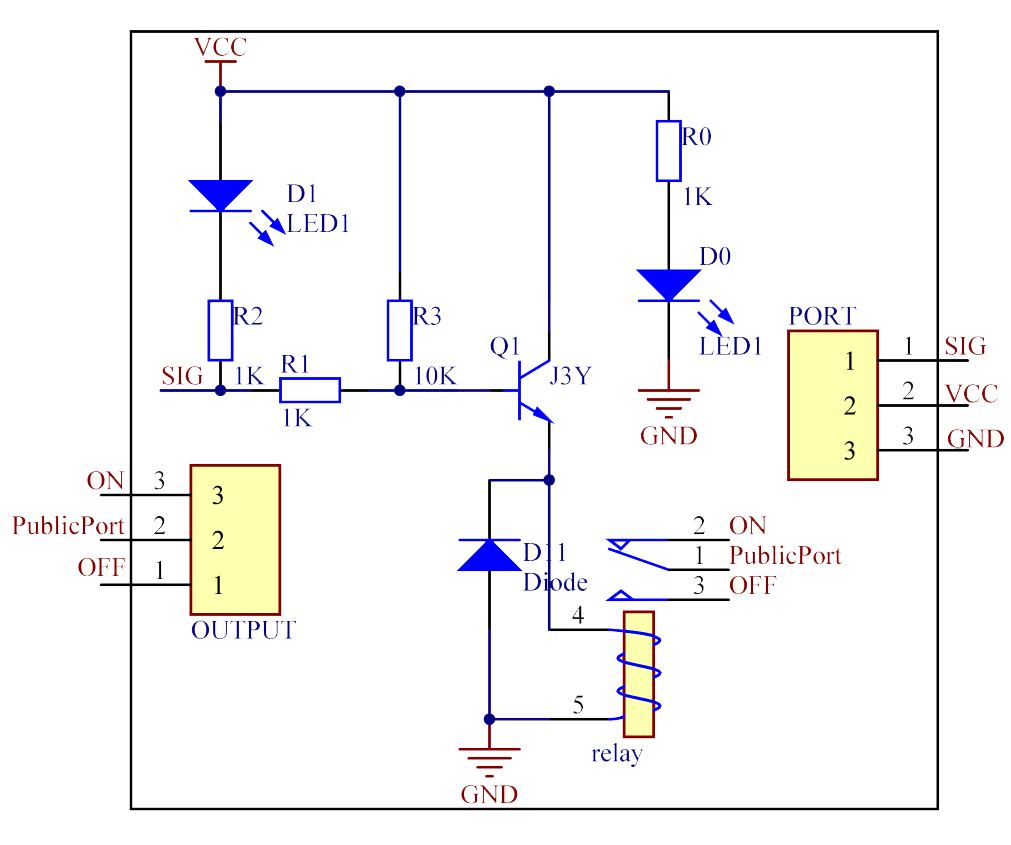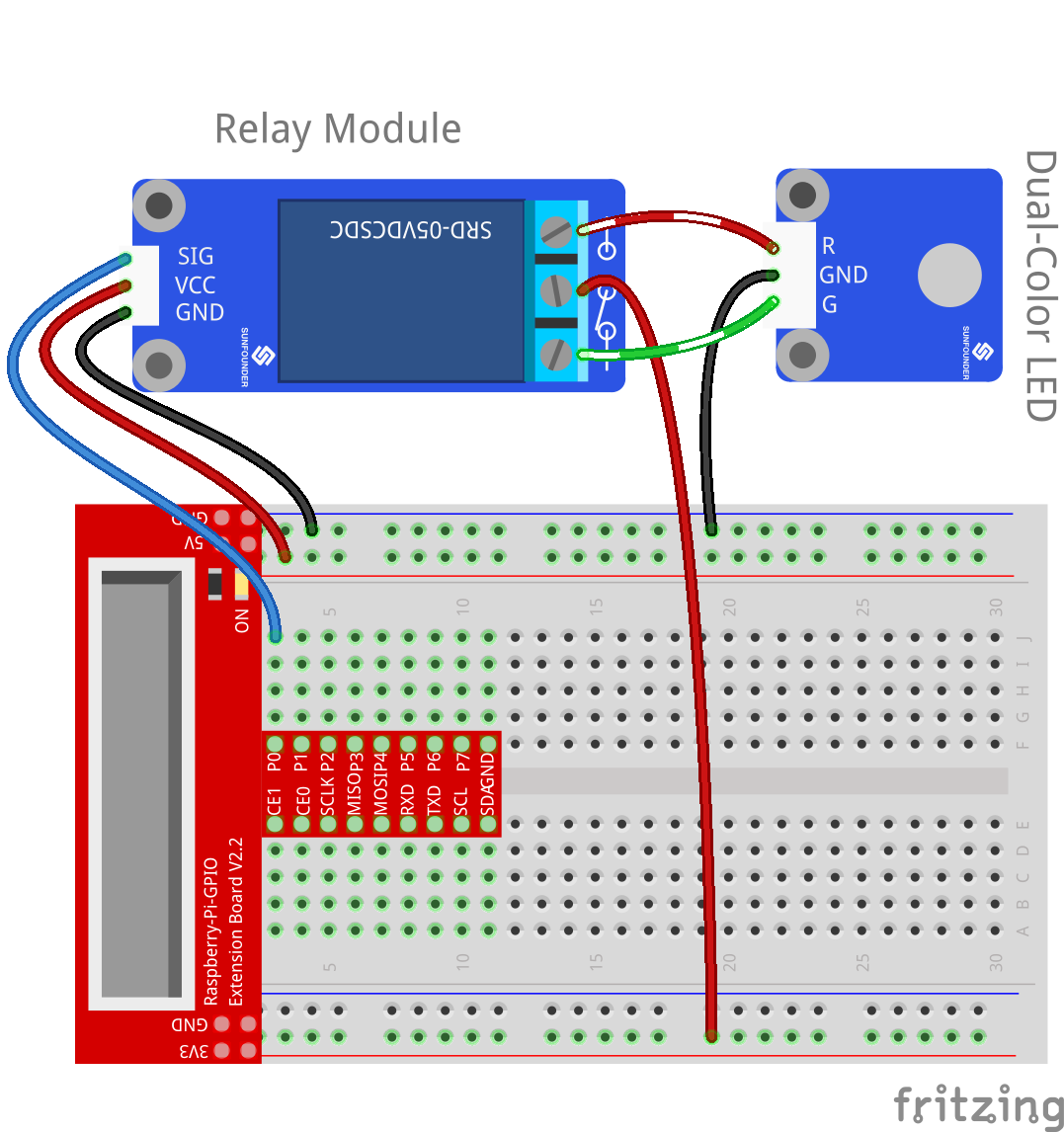Introduction
As we know relay is a device which is used to provide connection between two or more points or device in response to the input signal applied. In another words relay provide isolation between the controller and the device as we know devices may work on AC as well as on DC. However, they receive signals from microcontroller which works on DC hence we require a relay to bridge the gap. Relay is extremely useful when you need to control a large amount of current or voltage with small electrical signal.

Components
– 1 * Raspberry Pi
– 1 * Breadboard
– 1 * Network cable (or USB wireless network adapter)
– 1 * Relay module
– 1 * Dual-color LED module
– 2 * 3-Pin anti-reverse cable
Experimental Principle
Relay – There are 5 parts in every relay:
1. Electromagnet – It consists of an iron core wounded by coil of wires. When electricity is passed through, it becomes magnetic. Therefore, it is called electromagnet.
2. Armature – The movable magnetic strip is known as armature. When current flows through them, the coil is it energized thus producing a magnetic field which is used to make or break the normally open (N/O) or normally close (N/C) points. And the armature can be moved with direct current (DC) as well as alternating current (AC).
3. Spring – When no currents flow through the coil on the electromagnet, the spring pulls the armature away so the circuit cannot be completed.
4. Set of electrical contacts – There are two contact points:
. Normally open – connected when the relay is activated, and disconnected when it is inactive.
. Normally close – not connected when the relay is activated, and connected when it is inactive.
5. Molded frame – Relays are covered with plastic for protection.
Working of Relay
The working principle of relay is simple. When power is supplied to the relay, currents start flowing through the control coil; as a result, the electromagnet starts energizing. Then the armature is attracted to the coil, pulling down the moving contact together thus connecting with the normally open contacts. So the circuit with the load is energized. Then breaking the circuit would a similar case, as the moving contact will be pulled up to the normally closed contacts under the force of the spring. In this way, the switching on and off of the relay can control the state of a load circuit.

Connect the base electrode of the transistor to GPIO0. When we make GPIO0 output high level (3.3V) by programming, the transistor will conduct because of current saturation. The normally open contact of the relay will be closed, while the normally closed contact of the relay will be broken; when we make it output low level (0V), the transistor will be cut off, and the relay will recover to initial state.
The schematic diagram:

Experimental Procedures
Step 1: Build the circuit
| Raspberry Pi | Relay Module | Dual-color LED module |
| GPIO0 | SIG | * |
| 5V | VCC | * |
| GND | GND | GND |
| 3V3 | COM | * |
| * | Normal Open | R |
| * | Normal Close | G |

For C language users:
Step 2: Change directory
cd /home/pi/SunFounder_SensorKit_for_RPi2/C/04_relay/
Step 3: Compile
gcc relay.c –lwiringPi
Step 4: Run
sudo ./a.out
For Python users:
Step 2: Change directory
cd /home/pi/SunFounder_SensorKit_for_RPi2/Python/
Step 3: Run
sudo python 04_relay.py
Now, you should hear the ticktock. That’s the normally closed contact opened and the normally open contact closed. You can attach a high voltage device you want to control, like a 220V bulb, to the output port of the relay. Then the relay will act as an automatic switch.

C Code
#include <wiringPi.h>
#include <stdio.h>
#define RelayPin 0
int main(void)
{
if(wiringPiSetup() == -1){ //when initialize wiring failed,print messageto screen
printf("setup wiringPi failed !");
return 1;
}
// printf("linker LedPin : GPIO %d(wiringPi pin)\n",VoicePin); //when initialize wiring successfully,print message to screen
pinMode(RelayPin, OUTPUT);
while(1){
digitalWrite(RelayPin, LOW);
delay(1000);
digitalWrite(RelayPin, HIGH);
delay(1000);
}
return 0;
}Python Code
#!/usr/bin/env python
import RPi.GPIO as GPIO
import time
RelayPin = 11 # pin11
def setup():
GPIO.setmode(GPIO.BOARD) # Numbers GPIOs by physical location
GPIO.setup(RelayPin, GPIO.OUT)
GPIO.output(RelayPin, GPIO.HIGH)
def loop():
while True:
print '...relayd on'
GPIO.output(RelayPin, GPIO.LOW)
time.sleep(0.5)
print 'relay off...'
GPIO.output(RelayPin, GPIO.HIGH)
time.sleep(0.5)
def destroy():
GPIO.output(RelayPin, GPIO.HIGH)
GPIO.cleanup() # Release resource
if __name__ == '__main__': # Program start from here
setup()
try:
loop()
except KeyboardInterrupt: # When 'Ctrl+C' is pressed, the child program destroy() will be executed.
destroy()